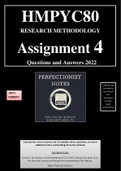[Type text]
HMPYC80
RESEARCH METHODOLOGY
Assignment 4
Questions and Answers 2022
Table format
included at
the end of
100 %
the
CORRECT document
for test
input
convenience
Contains the correct answers for 24 multiple choice questions, as well as
additional notes and headings from the textbook
TEXTBOOK USED:
Fouché, C. B.; Strydom, H. & Roestenburg, W. J. H. (2021). Research at grass roots:
For the social sciences and human service professions (5th Edition).
ISBN: 978-0-627-03821-1
,ASSIGNMENT 04 2022 –unique number 722289 (Worth 5 %)
Due date = 22 August 2022
To find the answers in the textbook: refer to chapter being asked and the page number provided in this guide.
_____________________________________________________________________________________________________________________
Chapter 20
Question 01
Which ONE of the following statements about mixed methods research is TRUE?
a) This is a "multimethod" where multiple forms of qualitative data (e.g. interviews and observations); or multiple forms of
quantitative data (e.g. survey data, experimental data) are collected in the same study.
b) This involves the collection of multiple forms of qualitative data or quantitative data.
c) This involves the collection, analysis and integration of both quantitative and qualitative data in different phases of a
study. The data need to be “mixed” in some way so that, they form a more complete picture of the problem than they do
standing alone.
d) The nature of quantitative and qualitative approaches is that these approaches are mutually exclusive.
ADDITIONAL NOTES QUESTION 1:
NOT A: (Fouche, et al, 2021, p892).
DEFINITELY C: (Fouche, et al, 2021, p893).
Answer = C
_____________________________________________________________________________________________________________________________________________
, Question 02
Mixed methods research organises the research procedures into specific research designs; and frames them within theory
and philosophy. This requires a high level of methodological expertise to guide the study through its different stages and
ensure the application of the most appropriate procedures at each point. The following does NOT apply to the values that
mixed methods research applies to research.
a) Triangulation. Mixed methods research encourages you to collaborate across the occasional antagonistic relationship
between quantitative and qualitative researchers. If findings are corroborated across different approaches, then greater
confidence can be held in the singular conclusion; if the findings conflict, then you have greater knowledge and can modify
interpretations and conclusions accordingly.
b) A QUAL ➝ quan study is usually followed, indicating a qualitatively driven sequential study where qualitative data
collection is followed by quantitative data collection with unequal priority.
c) Enrichment. Mixed methods research provides the opportunity for a greater assortment of divergent views and
perspectives and alerts you to the possibility that issues are more multifaceted than you may have initially supposed.
d) Guide the development of measuring instruments. Mixed methods research enriches the development of appropriate
tools based on the findings from either of the approaches (e.g. Interviews can inform survey design, or survey results can
inform interview schedules).
ADDITIONAL NOTES QUESTION 2:
A = Triangulation. Mixed methods research encourages you to collaborate across the….. (Fouche, et al, 2021, p895).
C = Enrichment. Mixed methods research provides the opportunity for a greater…….(Fouche, et al, 2021, p896).
D = Guide the development of measuring instruments. Mixed methods research…….(Fouche, et al, 2021, p897).
Therefore B does not apply.
Answer = B
_____________________________________________________________________________________________________________________________________________
Question 03
According to the typology or classification by Creswell and Plano Clark (2018) there are at least three key types of mixed
methods designs. The following does NOT apply to the (i) convergent design?
a) This is a triangulated, parallel or concurrent design, where you collect both qualitative and quantitative data, analyse
them separately and then merge and compare the results to see if they confirm or disconfirm each other.
b) This is a two-phase mixed methods design. The design starts with the collection and analysis of quantitative data
followed by the collection and analysis of qualitative data. The overall purpose of this design is that the qualitative data
help explain or build upon initial quantitative results from the study’s first phase.
c) This design involves the concurrent, but separate collection and analysis of quantitative and qualitative data – two
separate databases – to combine, compare and contrast the different findings at the stage of analysis, to see the extent to
which they do or do not agree with each other.
d) The researcher will design a concurrent or sequential quantitative and qualitative process for data collection and
analysis and use equal or unequal weighting to mix the results
ADDITIONAL NOTES QUESTION 3:
B DOES NOT APPLY = …simply referred to as an explanatory design, is a two-phase mixed methods design… (Fouche, et al,
2021, p. 913).
Answer = B




